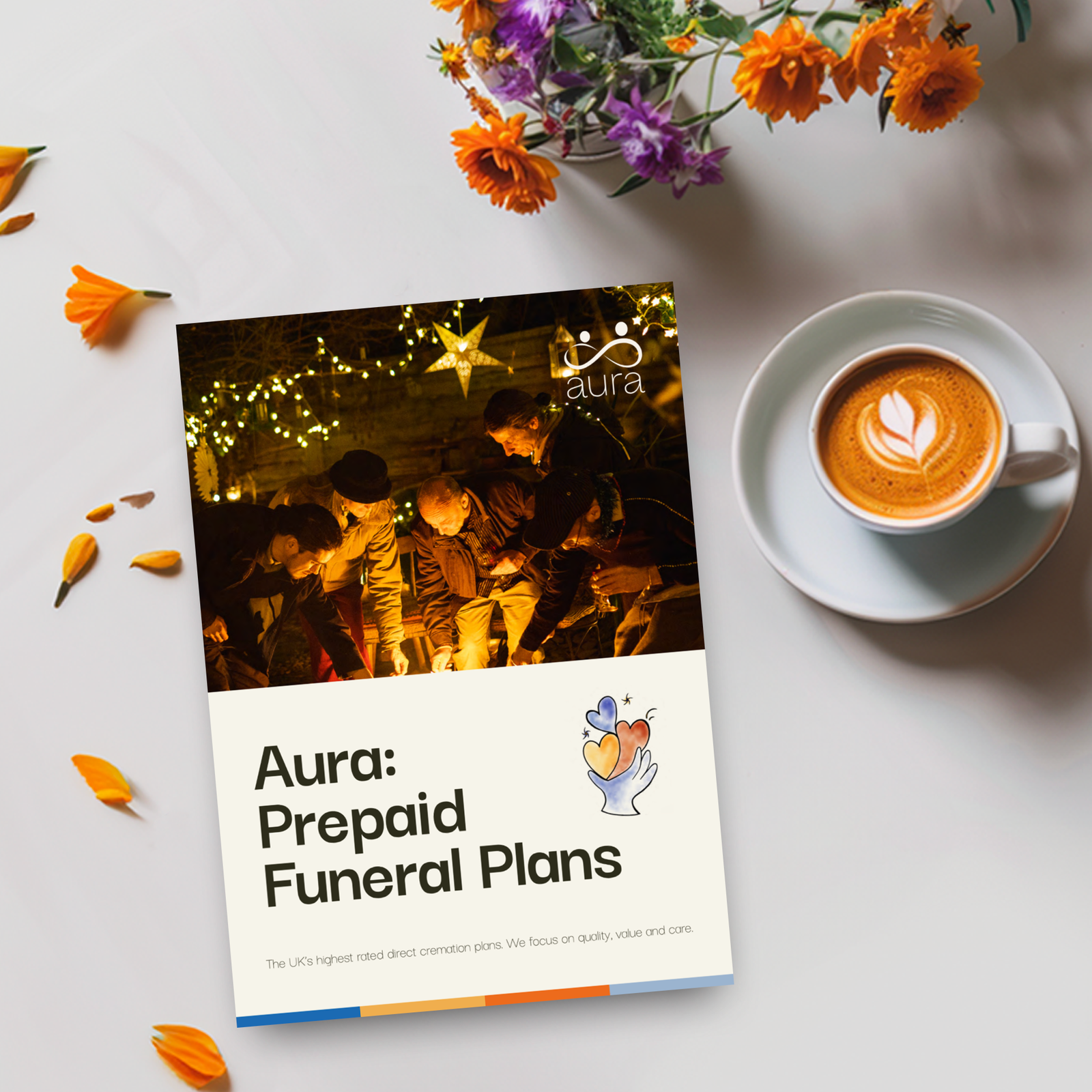


Written by Emily Cross.
17 minute read
Losing a loved one can bring emotional shock and grief, often alongside practical challenges. In some cases, surviving family members may need to make decisions not outlined in the will — such as changing how an inheritance is distributed.
We fully accept that this type of situation may sound overwhelming, but we are here for you. While our main focus is helping families with prepaid funeral plans and arranging e direct cremation services after someone has died, we believe our support shouldn’t end there.
In this guide, we’ll explain what to do when someone dies, especially if you need to make changes to how their inheritance is structured.These types of discussions may feel daunting, but our hope is that by taking time to read through your options, it may start to feel a little more manageable.
Important: This article is for general information only. Aura does not offer legal or tax advice. You should speak to a solicitor or regulated tax adviser for specific guidance.
Key takeaways:

The deed of variation is a legal document that allows the beneficiaries to change how their inheritance is distributed, provided they are in unanimous agreement and have signed. There are instances when the executor of the will may also need to sign the deed of variation. Gaining clarity on this issue by speaking with a solicitor may provide peace of mind.
For the deed of variation to be legally binding, it has to include the following:
If the deed of variation has inheritance tax implications, it must also be signed and executed within two years of the death of your loved one. While the importance of having a will cannot be overstated, many people are still dying without a will. In these cases, a deed of variation cannot change the laws of intestacy, but beneficiaries can agree to redistribute what they inherit under those rules.
The most common reason for using a deed of variation is to protect the inheritance against inheritance tax. Others use it to make the final settlement of the estate fairer.
Some people may feel that thinking about tax efficiency during grief is difficult, while others find it a helpful distraction.. Regardless of how you feel right now, it may be helpful to know that the deed of variation can be used to reduce inheritance tax and capital gains tax.
You may be able to reduce the estate’s tax bill by redirecting assets as though the person who died had gifted them at the time of their death.. Speaking with an independent tax planner may help you to navigate the complexities of this process in a way that is tax-efficient. Some families find that doing so is an effective way to help provide for family members who were not included in the original will.
All beneficiaries who are affected by the changes will need to agree and sign the document. If your inheritance is in no way affected by the changes outlined in detail in the deed of variation, you will not need to sign. That said, as the person in charge of the deed of variation process, you may find that it is helpful to discuss the changes with every beneficiary, affected or not. You may find that this helps make the process more transparent and easier for everyone in the family to understand.
There are also situations where a deed of variation is not possible. These include, but are not limited to the following situations laid out by Gov.uk:
To be legally binding, a deed of variation must include:
HMRC must be notified if the changes result in more tax being due.
Achieving a greater sense of fairness and reducing inheritance liability are two of the most common reasons for using a deed of variation.
Perceived fairness can be one of the harder issues to resolve when someone in the family dies and leaves an inheritance. Some families may decide that they see it as right and proper to use a deed of variation to restructure the inheritance so that the estate provides for family members who were previously left out of the will.
One of the most common reasons for doing so is to redirect assets to those in greater financial need. Such decisions are deeply personal and for the beneficiaries to make unanimously. At a time when emotions can understandably run high, you may find it helpful to take a step back. Giving yourself time and space for a period of reflection may help you see things from other points of view.
Redistributing assets can minimise the inheritance tax liability. This is because the deed of variation allows you to change the distribution of property, money, and other valuables as if the person who has died gifted them on the day of their death. It also allows you to transfer assets into a trust with the aim of shielding them from tax. By its very nature, this can quickly become a complex and time-consuming process, in which case you may decide to speak with a tax planning professional.
It is perfectly natural to want to safeguard inheritances from creditors, divorce settlements, or even bankruptcy. Some tax advisors may recommend a series of charitable donations from the estate to help reduce the exposure of the remainder of the estate. Again, you may wish to discuss this with a professional and then sit down as a family and talk through your options. If you find that you need to take a break from the discussions to process your grief, this is completely justifiable.
For the deed of variation to be legally binding, it is important to follow a strict set of requirements while creating, signing, and executing it. A solicitor will be able to provide advice on each stage to ensure nothing is accidentally missed or overlooked.
The deed of variation has to be executed within two years of the death of your loved one if it has inheritance tax implications. Here are the various components that the deed of variation must contain under UK law:
HMRC and the UK legal system both dictate that the deed of variation needs to be written in compliance with the Inheritance Tax Act 1984 and the Taxation of Chargeable Gains Act 1992. If you are unfamiliar with the nuances of these acts, you may wish to consider the services of a local solicitor who will be able to guide you through the process.
Here are the key legal steps in the execution process, as outlined by Gov.uk:
In cases where the changes made alter the inheritance tax liability, HMRC will also need to be notified so that they can adjust the tax liability of the estate. Due to the complex nature of such changes, you may wish to have a legal representative present during the signing process. Some families find that this offers a greater sense of clarity and gives them more peace of mind.
Creating a deed of variation can be a potentially tedious and time-consuming process when you are already trying to grieve. Understanding the costs and legal ramifications may help you clarify your thinking.
Every deed of variation is different because it has to deal with a unique estate and a unique will. While it may be tempting to try and create the document yourself, many people find that the complexity of the tax system and the legal system require the services of a solicitor. In this case, the cost of the deed of variation will be influenced by the solicitor’s fees for the time spent working on the document, the size, nature, and complexity of the estate, as well as the nature of the changes requested.
While we always aim to help, you may wish to think about hiring a solicitor. Requesting and comparing quotes is the next step that some families feel is right for them.
Because the deed of variation can be used to gift property, money, and valuables out of the estate as if the person who has died did so on the day they died, the tax liability of the estate can change. This can affect both inheritance tax and capital gains tax, both of which are collected by HMRC.
HMRC’s guidelines state that you have 6 months to notify of a deed of variation if the changes described in the document result in the estate paying more tax. While there are cases where extensions have been granted, you may find it helpful to make a note of this deadline so you have it for future reference.
If you are reading this guide and feel that you have other questions related to how an estate is to be handled, we are always here to help. Our guides cover things such as how to gain power of attorney, what is probate, and how to set up a trust. Although a trained solicitor will be able to help you with all of these and more, you may find that having a working knowledge of the relevant processes makes them more accessible. Others may find that it helps them understand their options in a way that goes some way to reducing their worries.
The process of dealing with an unexpected death, or any death, is one that we each work through in our own way. Regardless of your circumstances, you may find it helpful to seek professional legal and financial advice so that you understand your options.
Losing someone close to you is an emotional and often confusing time, no matter your relationship or circumstances. For example, knowing how to cope when a parent dies is as much about seeking help with practical matters as it is about processing your own emotions. Large estates, cross-border estates, and estates with a large number of beneficiaries with competing interests can all present a complex legal and financial picture.
A solicitor or trained tax advisor will be well-versed in the technical nature of creating a deed of variation and will be able to advise accordingly. Although you may feel like hiring someone is the last thing you want to face right now, doing so may actually help relieve some of the pressure you are feeling. Some families find that having a professional they can trust helps provide peace of mind and gives them additional time and space to focus on the grieving process.
One of the issues with creating a deed of variation by yourself is that there are a series of rules set out by HMRC and some legal requirements that you need to abide by. Late or untimely execution, a simple drafting error that was an honest mistake, or an unwitting omission can each cause delays and unwanted stress.
Many families in the UK find that a deed of variation is a challenging and time-consuming undertaking of a highly technical nature. Even if they choose to get heavily involved in the process, many find that having a legal professional overseeing and directing matters provides a sense of calm.
If you feel able to connect with a local solicitor at this time, you may find that it helps you to clarify your thinking by giving you someone knowledgeable you can direct questions to. They will also be able to guide you through the process from beginning to end so that you avoid the common pitfalls touched on above.
While we primarily focus on funeral services and providing guidance that can help you compare funeral plans, we know from experience that the death of a loved one can create so many other needs. A big part of what you may be experiencing right now is the need for clarity, purpose, and direction. Our focus during this guide has been to try and provide some sense of this with regard to the subject of the deed of variation.
We completely understand that there is a human side here and that not everyone will feel comfortable with the legal system, but we have also seen the positive impact clear explanations can sometimes have. We are always here for you, as is our constantly expanding online library of guides and resources.

Our brochure includes all the details you need surrounding our prepaid direct cremation funeral plans.
Get your free brochure sent by email or First Class post by clicking on the link below.
A deed of variation is a legally binding document that beneficiaries can use to change how their inheritance is distributed. While the will represents the final wishes of the person who has died, there are cases where the beneficiaries are legally allowed to go against those wishes using a deed of variation. They can also use it to change the rules of intestacy that come into effect when there is no will left by the person who has died. Changes that can be made include the redistribution of property and valuables and the addition of new beneficiaries not named in the will.
The beneficiaries will have a series of tax exemptions and tax reliefs as dictated by their own individual circumstances. Some families choose to look at things such as partial gifting to charities and the reallocation of beneficiaries to reduce their liability.
While offering advice on what to do goes beyond the scope of this guide, you may decide that you wish to contact a local independent tax advisor. They will be able to talk you and the rest of the family through your options and give you additional clarity on the best way forward given your individual circumstances.
Every beneficiary named in the original will who subsequently wants or needs to vary their entitlement will need to sign the deed of variation. Any variation that also impacts other beneficiaries will need to be signed by all of those impacted. There are also some cases — depending on the nature of the variation — where the executors and administrators of the estate will need to add their signatures. It may be the case that you find consulting an independent professional is the best course of action.
Yes, it is possible to legally contest a deed of variation. A common reason for doing so would be if you have concerns regarding fairness and undue influence, another is if you feel there is insufficient understanding on the part of the beneficiaries. Because every affected beneficiary needs to sign, and often the executor, you can use your affected status to pause proceedings and contest the proposed changes.
Yes, the deed of variation is a legally binding agreement that becomes valid as soon as it is fully signed and lawfully executed. All of the agreed alterations will be outlined in explicit detail, ensuring that all beneficiaries are aware of their new inheritances and the manner in which they will be structured and distributed. It is important to note that if the changes are going to impact the inheritance tax liability of the estate, the deed of variation needs to be signed and executed within two years of the date on the death certificate.
According to Gov.uk, the deed of variation has a two-year deadline by which point it must be completed for it to become legally binding. While there may be cases where exceptions have been made, making a note of the two-year deadline may help you to navigate undue sources of stress and causes of delay.
While a deed of variation does not change the probate process itself, it can alter how the estate is distributed once probate is complete. Because it is a change to the wishes as laid out in the will, it is legally altering the instructions left behind by the person who has died. The deed of variation can be signed and executed before or after probate and can lead to delays in either case. Speaking with an independent legal specialist may help you to clarify and understand your options so you can make a decision that is in the best interests of all the affected beneficiaries.
The deed of variation consists of a written document that must explicitly outline all of the changes to the distribution of property, money, and other valuables contained within the estate. A statement of intent is also added to explain the reason every signatory is agreeing to the changes. Because of the complex nature of the legal system, and the need for precise wording, some families choose to hire a solicitor to take care of the drafting process. This may help you achieve peace of mind and will ensure that nothing is unwittingly overlooked.
staging site last replicated: MISSINGNO.